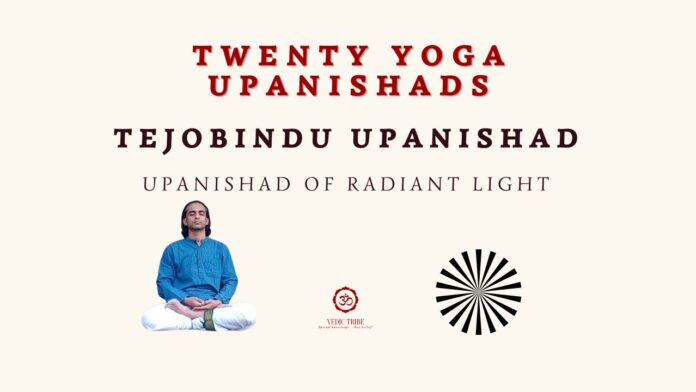What is fifteen limbed Yogic practice?
In the previous article, we discussed Kshurika Upanishad and in this article, we will discuss – Tejobindu Upanishad.
Fifteen limbs: Unlike the famous Ashtanga Yoga of Patanjali, Tejobindu Upanishad prescribes a fifteen limbed Yogic practice. First ten steps explain preparation and next five steps explain the process of meditation.
Advaita: Teachings of this Upanishad also contains concepts of Advaita Vedanta. For example, in third chapter contains verses “I am Parabrahma, I am the ultimate bliss”…etc. The Upanishad also calls the sentence “Aham Brahmasmi” as “Atma-Mantra”.
Like other Upanishads, this Upanishad also discusses the concept of “Jeevanmukti” (this is explained in the Article titled Nadabindu Upanishad).
Fifteen limb Yoga:
The Tejobindu Upanishad distinguishes itself from other Yoga Upanishads and the Yoga Sutras by outlining a fifteen-limbed yogic process:
1. Yama – Self control
2. Niyama – Right observances
3. Tyaga – Renunciation
4. Mauna – Silence
5. Desa – Right place and seclusion
6. Kala – Right time
7. Asana – Correct posture
8. Mula-bandha (yogic root-lock technique),
9. Dehasamyama (body equilibrium, no quivering),
10. Drksthiti (mind equilibrium, stable introspection),
11. Pranasamyama (breath equilibrium),
12. Pratyahara (withdrawal of senses),
13. Dharana (concentration),
14. Atma-dhyana (meditation on Universal Consciousness), and
15. Samadhi (dissolution of mind)
The concept of Advaita:
Existing concepts: In popular belief, Sri Shankaracharya is considered the first proponent of Advaita Vedanta. However, it should be noted that the key concepts of Advaita Vedanta were already part of later Upanishadic texts like Tejobindu Upanishad.
Philosophical enquiry: It should be noted that, in general Upanishads do not contain a rigorous philosophical enquiry, instead they lay down propositions. It is “Darshana Shastra” which conducts such rigorous philosophical enquiry. One such Darshana is Vedanta Darshana and Sri Shankaracharya established Advaita Vedanta Darshana by adopting the aforesaid concepts from Upanishads. Sri Shankaracharya presented a rigorous philosophical enquiry by rejecting other Darshanas like Samkhya. His philosophical enquiry was further developed and become one of the traditional sub-schools of Vedanta.
Neo-Vedanta: In 19th century an intellectual movement called “Neo-Vedanta” emerged where modern interpretations were adopted to incorporate few western ideas into traditional Indian schools of thought, especially Advaita Vedanta. For example, Swami Vivekananda presented a new philosophical approach to fuse different Darshana together – a departure from the traditional school of Advaita Vedanta. He incorporated universal views of philosophy into the traditional concepts of Advaita. Specially in his book “Raja Yoga” he presents his interpretation of Patanjali’s Yoga sutra in the light of Advaita school of thought. One can find a wider influence of Yoga Upanishad also in his works.
Key takeaways:
– If you are an advanced practitioner, you may study this Upanishad and adopt its teachings.
– If you are interested in knowing early Advaita philosophical texts, you may learn this Upanishad from a scholar.
In the next article, we will discuss – “Nadabindu Upanishad”.
Madhwesh K
Vedic Tribe

